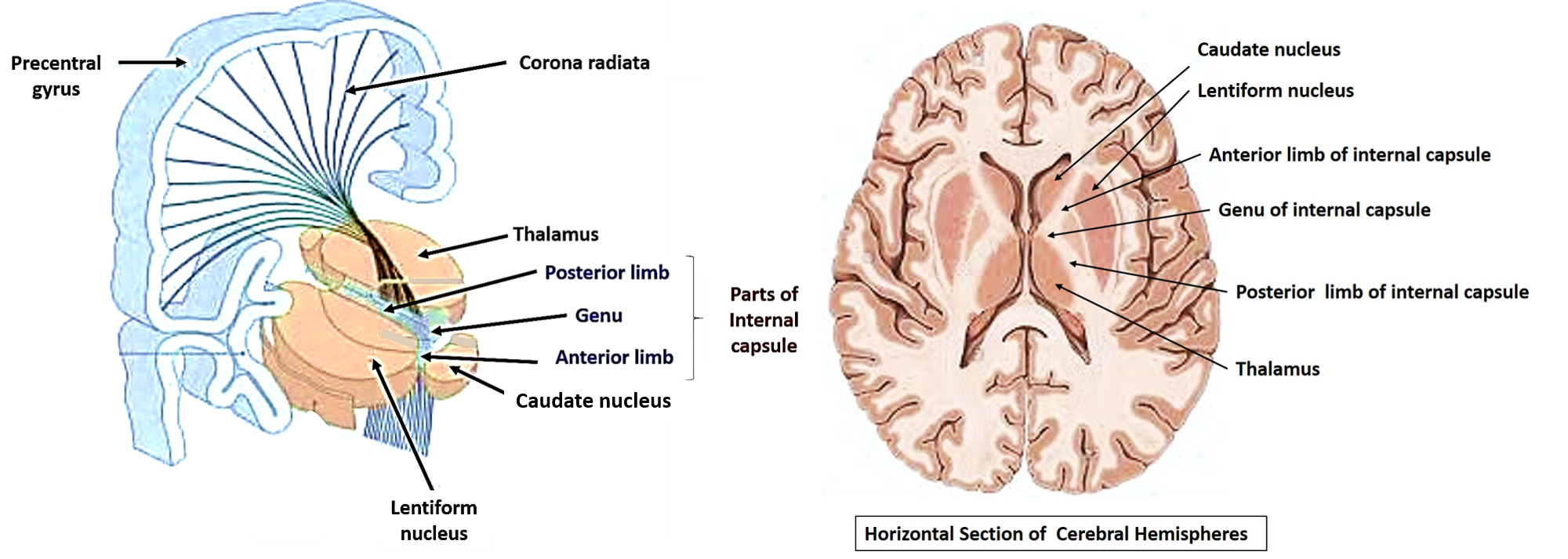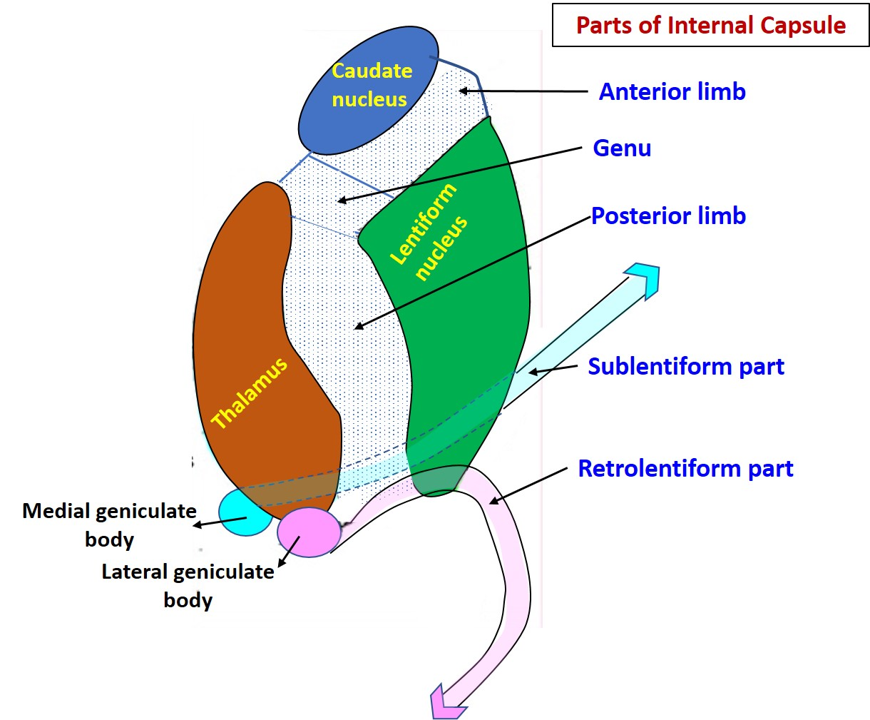Where is internal capsule located?
Internal capsule is a broad band of ascending(sensory) and descending (motor) fibers to and from the cerebral cortex. It is continuous above with the fan-shaped corona radiata and below with the crus cerebri.
Location: Internal capsule is located between the lentiform nucleus laterally and the thalamus and caudate nucleus medially. In a horizontal section of cerebral hemisphere, the internal capsule appears as a V-shaped bundle of fibers with the apex directed medially.

What are the parts of internal capsule?
The internal capsule is divided into five parts.
- Anterior limb: part of the internal capsule that lies between the anterior part of lentiform nucleus laterally and head of caudate nucleus medially.
- Genu: It is the bend between the anterior and posterior limb of internal capsule. The concavity of the bend faces laterally.
- Posterior limb: is that part of internal capsule which lies between the thalamus medially and the posterior part of lentiform nucleus laterally.
- Retrolentiform part: is located posterior to the lentiform nucleus.
- Sublentiform part: is located inferior to the lentiform nucleus.

Name the constituent fibers of internal capsule.
Constituent fibers: Internal capsule contains both the motor ( descending/corticofugal) fibers and sensory (ascending/corticopetal) fibers
Motor/Descending Fibers in Internal Capsule
Following are the motor fibers in the internal capsule:
- Corticospinal: originate mainly in primary motor cortex and relay in contralateral anterior horn of spinal cord.
- Corticonuclear: originate mainly in primary motor cortex and relay usually in contralateral (some bilateral) motor nuclei of cranial nerves.
- Corticopontine :originate from all the lobes of cerebrum and relay in ipsilateral pontine nuclei. The pontocerebellar fibers from the pontine nuclei cross the midline to reach cerebellum via corticico-ponto-cerebellar pathway).
- Coticorubral, corticostriate, corticonigral fibers etc.: these fibers originate in the motor and premotor areas of cerebral cortex relay in subcortical nuclei viz. red nucleus, corpus striatum and substantia nigra respectively.
Sensory/Ascending Fibers in Internal capsule
Thalmocortical fibers: Most of the thalamocortical fibers are the 3rd order neurons of ascending pathways. Thalamocortical fibers are arranged in four broad band that radiate from the thalamus to cerebrum. The four thalamic radiation bands are:
- Anterior thalamic radiation: Pass anteriorly to connect the anterior and dorsomedial nucleus of thalamus to the frontal lobe.
- Superior thalamic radiation: Pass superiorly to connect the ventral tier of nucleus of thalamus to primary and premotor areas of frontal lobe (ventral anterior and ventral lateral nucleus of thalamus) and sensory areas of parietal lobe (ventral posterolateral and ventral posteromedial nuclei of thalamus).
- Posterior thalamic radiation (Optic radiation): pass posteriorly to connect the lateral geniculate body to the primary visual cortex.
- Inferior thalamic radiation (Auditory radiation): pass inferiorly and laterally to connect the medial geniculate body to the primary auditory area.

Where are the motor and Sensory fibers arranged in the Internal capsule.
| Part of Internal capsule | Motor fibers | Sensory fibers |
|---|---|---|
| Anterior limb | Frontopontine fibers | Anterior thalamic radiation |
| Genu | Frontopontine fibers, Corticonuclear and Corticospinal fibers for head and neck region respectively | Superior thalamic radiation |
| Posterior limb | Corticospinal fibers for trunk and limbs, Corticorubral fibers | Superior thalamic radiation |
| Retorlentiform part | Parietopontine and Occipitopontine fibers | Posterior thalamic ( Optic) radiation |
| Sublentiform part | Parietopontine and Occipitopontine fibers | inferior thalamic ( Auditory) radiation |
Draw labelled diagram to show the arterial supply of Internal capsule.
The following diagram shows the arteries supplying the various parts of the internal capsule:

Applied Aspect
Why damage to a small part of internal capsule can have devastating consequences?
This is because the descending (motor) and ascending (sensory) fibers are all concentrated in a narrow bundle in the internal capsule,therefore, a small lesion may result in hemiplegia and loss of sensations in the opposite half of the body.
Which artery is known as ‘ artery of cerebral haemorrhage’ and why?
The largest lateral striate branch of middle artery is known as Charcot’s artery of cerebral haemorrhage , because the haemorrhage in internal capsule most commonly occurs due to rupture of this artery. It supplies posterior limb of the internal capsule. Rupture of this artery results in spastic paralysis of muscles of opposite half of the body (hemiplegia) due to involvement of the corticospinal tracts and extrapyramidal fibers for the limbs and trunk.
What will be the effect if there is thrombosis/rupture of ‘recurrent artery of Heubner’?
Thrombosis/rupture of recurrent artery of Heubner will result in paralysis of muscles of lower half of face and upper limb on the opposite side due to the involvement of corticonuclear fibers in genu of the internal capsule and the corticospinal fibers for upper limb in the adjacent part of posterior limb of internal capsule.

I am a 71 year-old disabled combat veteran attempting to learn neuroanatomy. May I copy one copy information for my personal edification? I am not a college student. This information will be shared with nobody else: only me.
Ed
Awsome knowledge
Just perfect👌👌
Good material for study.